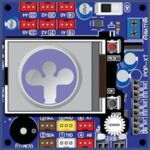Electronic Product Production.
a. PCB Assembly.\
\
First Inspect PCB for hairline shorts and cuts and also traces of unwanted copper in the edges and repair them. Also Check if all Drill holes & Slots are proper size and PCB is Fitting in its Place properly, This is because Drilling and Filing should not be done after assembly as it causes serious reliability problems.

\[teaserbreak\]Second populate all the resistors, Jumpers, Diodes and Ceramic Capacitors these are tough components. Then Insert all Transistors, LEDs, Displays, Electrolytic Capacitors and IC s (Bases), Here care should be taken not to overheat any component as it may damage them. Lastly Solder Connectors, Relays, Coils and Transformers which may require a high wattage Iron, and Mechanical Reinforcements.\
\
b. Precautions during Production.
- Observe Polarity for Diodes, El-caps, Connectors, etc.
- Make sure of Pin 1 for IC s, Regulators, Transistors and Mosfets before insertion.
- Avoid bases for ICs in production as these fail on use.
- Make use of Electrostatic protection for CMOS devices.
- When Cutting Leads use protective Goggles and do it in a separate place as the cut leads fly all over the place.
- Use Iso Propyl Alcohol (IPA) as de-greasing agent on PCB.
- Water & Detergent wash is very good but only if coils, Transformers, Relays are hermetically sealed- Impregnated.
Use a Lacquer-Varnish or RTV rubber coat on both sides of PCB including on the components to prevent corrosion and also it helps maintain accuracy-precision.\
\
Lead is a kind of poison, use gloves or wash hands with soap after work is over. Flux, IPA, Thinner Fumes can cause respiratory health problems. Work in a ventilated area use Exhaust Fans and Open Windows. Dispose of Metal, Plastic and Chemical waste separately and well packed as these can contaminate the environment and also cause Injury.\
\
_Published online around - Nov 1999_


